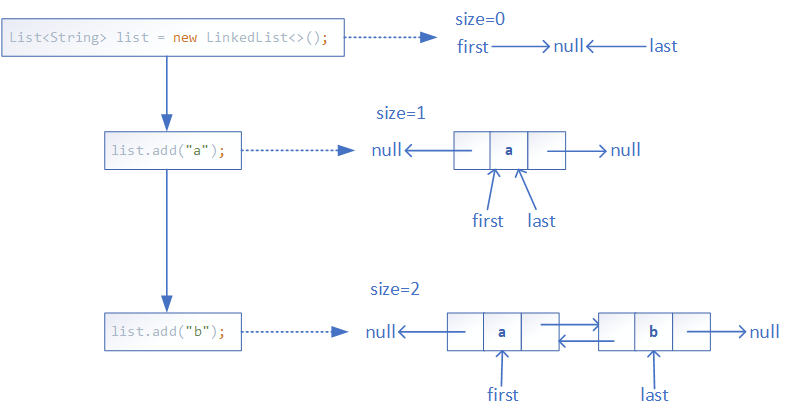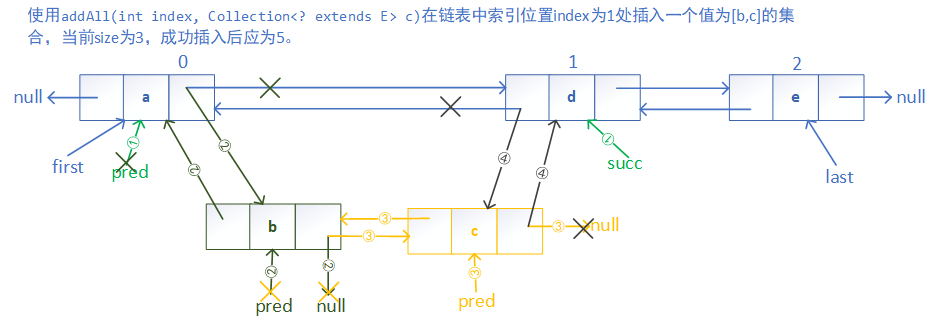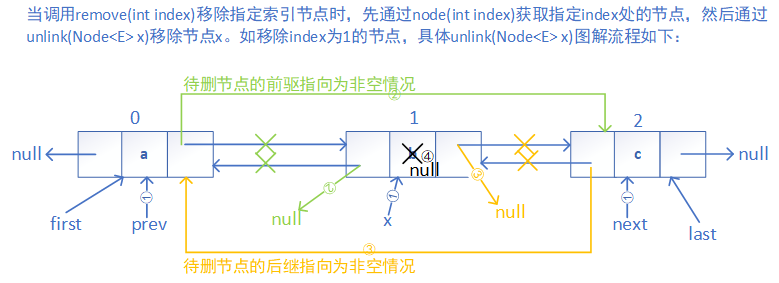1. 简介
LinkedList是基于双向链表实现。它是一种可以在任意位置进行高效地插入和移除操作的有序序列。
LinkedList是线程不安全的,若需在多线程环境使用,主要方法有:
① 使用List list = Collections.synchronizedList(new LinkedList(…));
② 使用ConcurrentLinkedQueue;
③ 使用synchronized关键字。
LinkedList在jdk1.6时为带有头结点的双向循环链表,jdk1.7和jdk1.8为不带头结点的普通的双向链表,示意图如下:
从下图可以得知,LinkedList继承于AbstractSequentialList,实现了List、Deque、Cloneable、java.io.Serializable这些接口。
- 继承AbstractSequentialList抽象类,提供序列化访问,只支持按次序访问,不像AbstractList那样支持随机访问。
- 实现List接口,提供了List接口的所有方法实现。
- 实现Deque接口,使得LinkedList具有双端队列特质。
- 实现Cloneable接口,支持可拷贝,即覆盖了函数clone()。
- 实现java.io.Serializable接口,支持序列化。

2. 属性与存储模型
2.1. 属性
size
1 | transient int size = 0; |
实际元素个数,存放当前链表有多少个节点。
first
1 | transient Node<E> first; |
指向链表的第一个节点的引用。Invariant: (first == null && last == null) || (first.prev == null && first.item != null)。
last
1 | transient Node<E> last; |
指向链表的最后一个节点的引用。Invariant: (first == null && last == null) || (last.next == null && last.item != null)。
2.2. 存储模型
Node为LinkedList的内部类,是实际存放元素的地方。1
2
3
4
5
6
7
8
9
10private static class Node<E> {
E item; // 元素
Node<E> next; // 下一个节点
Node<E> prev; // 上一个节点
Node(Node<E> prev, E element, Node<E> next) {
this.item = element;
this.next = next;
this.prev = prev;
}
}
3. 构造方法
LinkedList提供了二种方式的构造函数,分别如下:
LinkedList()
public LinkedList():无参构造函数,构造一个空列表。1
2public LinkedList() {
}
LinkedList(Collection<? extends E> c)
public LinkedList(Collection<? extends E> c):构造一个包含指定集合的列表。1
2
3
4public LinkedList(Collection<? extends E> c) {
this(); // 调用无参构造函数
addAll(c); // 将指定集合c添加至当前链表末尾
}
这里addAll(int index, Collection<? extends E> c)方法逻辑详见下面常用方法的分析,点击此处跳转。
4. 常用方法
总述
在学习LinkedList的常用方法时,其内部主要的辅助方法主要有:
private void linkFirst(E e):在链表头部插入一个新元素。
void linkLast(E e):在链表尾部插入一个新元素。
void linkBefore(E e, Node<E> succ):在某个非空节点前插入一个新元素。
private E unlinkFirst(Node<E> f):移除链表中的第一个节点,并返回旧值。
private E unlinkLast(Node<E> l):移除链表中的最后一个节点,并返回旧值。
E unlink(Node<E> x):移除链表的一个非空节点,并返回旧值。
add(E e)
public boolean add(E e):添加指定值为e的节点至当前链表的尾部。1
2
3
4
5
6
7
8
9
10
11
12
13
14
15
16
17
18
19
20
21public boolean add(E e) {
linkLast(e); // 添加一个值为e的新节点至链表尾部
return true;
}
// 添加一个新节点至链表末尾,并更新first和或last指向
void linkLast(E e) {
// 记录原尾节点位置给l,且l为final类型,不可更改
final Node<E> l = last;
// 生成一个新节点:前驱指向当前链表的尾节点,值为e,后继指向null
final Node<E> newNode = new Node<>(l, e, null);
// 更新last指向新节点newNode
last = newNode;
if (l == null) // 若l为null,说明刚添加的newNode为第一个节点,将first指向第一个节点newNode
first = newNode;
else // 若l非null,则将l的后继指向新节点newNode
l.next = newNode;
// 更新size加1
size++;
// 更新modCount加1
modCount++;
}
整体流程:记录当前链表的last位置为l –> 生成一个新节点(前驱指向链表尾节点,值为e,后继指向null) –> 更新last指向新生成节点;若l为null,更新first指向新生成节点,否则,令链表中原尾节点指向新生成节点 –> 更新size和modCount都加1 –> 添加成功,返回true。
【注1】 LinkedList链表调用add(E e)方法添加新元素时结构变化过程以及示意图。
LinkedList新增元素的示例代码如下:1
2
3List<String> list = new LinkedList<>();
list.add("a");
list.add("b");
根据上述代码执行过程,具体结构变化示意图如下:
add(int index, E element)
public void add(int index, E element):在指定位置index插入一个值为element的新节点。
1 | public void add(int index, E element) { |
整体流程:检查待插位置index是否越界 –> 若待插位置index等于链表中节点大小,则将新节点插入至链表末尾,否则插入至链表中间。
这里插至尾部的方法为linkLast(E e),前面add(E e)方法中已有详细分析,此处不再赘述;
而插至中间的方法为linkBefore(E e, Node
linkBefore(E e, Node
linkBefore(E e, Node
addAll(Collection<? extends E> c)和addAll(int index, Collection<? extends E> c)
public boolean addAll(Collection<? extends E> c):将指定集合c中的所有元素插入至当前链表末尾。public boolean addAll(int index, Collection<? extends E> c):将指定集合c插入链表中index处位置。
addAll()有两个重载函数,其中addAll(Collection<? extends E> c)内部会调用addAll(int index, Collection<? extends E> c),故此着重分析addAll(int index, Collection<? extends E> c)方法。1
2
3
4
5
6
7
8
9
10
11
12
13
14
15
16
17
18
19
20
21
22
23
24
25
26
27
28
29
30
31
32
33
34
35
36
37
38
39
40
41
42
43
44
45
46
47
48
49
50
51public boolean addAll(Collection<? extends E> c) {
// 将集合c插至链表中size处位置,即插至尾部
return addAll(size, c);
}
public boolean addAll(int index, Collection<? extends E> c) {
// 检查待插位置index是否越界
checkPositionIndex(index);
// 将参数集合c转为Object型数组
Object[] a = c.toArray();
// 令numNew为参数集合c的长度
int numNew = a.length;
// 若待插集合c为空,则返回false
if (numNew == 0)
return false;
// pred指向待插节点位置的前一个节点,succ指向待插节点位置的后一个节点
Node<E> pred, succ;
if (index == size) {
// 若插至尾部,则令succ指向null,pred指向链表中的尾节点last
succ = null;
pred = last;
} else {
// 若插至中间,则令succ指向index处的节点,pred指向index处前一个节点
succ = node(index);
pred = succ.prev;
}
// 遍历集合中所有元素,使其按次序插入链表中
for (Object o : a) {
("unchecked") E e = (E) o; // 待插元素转型
// 新生成一个节点:前驱指向pred,值为e,后继指向null
Node<E> newNode = new Node<>(pred, e, null);
if (pred == null) // 若pred指向null,说明待插位置为首位节点,需更新first指向新节点
first = newNode;
else // 若pred指向非null,则令pred的后继指向新节点
pred.next = newNode;
// 移动pred指向新节点,使得下一个元素接着插入至当前新节点的后面
pred = newNode;
}
if (succ == null) { // 若是插入尾部,更新last指向pred
last = pred;
} else { // 若是插至中间,令参数集合c中最后一个元素生成的节点pred的后继指向succ,succ的前驱指向pred
pred.next = succ;
succ.prev = pred;
}
// 更新size加参数集合c的长度
size += numNew;
// 更新modCount加1
modCount++;
return true;
}
整体流程:检查待插位置是否越界 –> 将参数集合c转为Object型数组a,并获取数组长度给numNew –> 若数组a长度为0,则返回false,否则继续执行插入操作 –> 判断index与当前链表长度size是否相等,来决定pred和succ的指向(pred指向待插节点位置的前一个节点,succ指向待插节点位置的后一个节点) –> 遍历待插所有元素,按次序分别生成新节点,并让新节点前驱指向前一个节点,前一个节点后继指向新节点 –> 若succ指向null,则更新last指向最后一个节点,否则,插入的最后节点的后继与succ的前驱相互指向 –> 更新size加上已插元素数以及modCount加1 –> 所有元素插入成功,返回true。
具体执行流程示意图如下所示:
set(int index, E element)
public E set(int index, E element):将链表中索引位置index处元素替换为元素值E。1
2
3
4
5
6
7
8
9
10
11
12
13
14
15
16
17
18
19
20
21public E set(int index, E element) {
// 越界检查
checkElementIndex(index);
// 取出指定index处的节点赋给x(node(int index)方法上面已分析过)
Node<E> x = node(index);
// 取出指定index处的旧值赋给oldVal
E oldVal = x.item;
// 将参数中指定元素element赋给index处元素
x.item = element;
// 返回旧值oldVal
return oldVal;
}
// 检查索引index是否越界,若越界,则抛出IndexOutOfBoundsException异常
private void checkElementIndex(int index) {
if (!isElementIndex(index))
throw new IndexOutOfBoundsException(outOfBoundsMsg(index));
}
// 对索引index进行越界检查,是否属于[0,size)
private boolean isElementIndex(int index) {
return index >= 0 && index < size;
}
整体流程:检查待替换位置是否越界 –> 从链表头/尾处循环遍历取出待替换位置的节点 –> 取出旧值并暂存 –> 替换新元素 –> 返回刚暂存的旧值。
element()、getFirst()和getLast()
public E element():获取链表中的第一个节点的元素值。public E getFirst():获取链表中的第一个节点的元素值。public E getLast():获取链表中最后一个节点的元素值。1
2
3
4
5
6
7
8
9
10
11
12
13
14
15
16
17
18
19
20
21
22
23
24public E element() {
// 通过调用getFirst()获取头节点的元素
return getFirst();
}
// 获取链表中第一个元素的值
public E getFirst() {
// 获取链表头节点,并赋给f
final Node<E> f = first;
// 若f为空,则抛出NoSuchElementException异常
if (f == null)
throw new NoSuchElementException();
// 返回头节点f的元素值
return f.item;
}
// 获取链表中最后一个元素的值
public E getLast() {
// 获取链表尾节点,并赋给l
final Node<E> l = last;
// 若l为空,则抛出NoSuchElementException异常
if (l == null)
throw new NoSuchElementException();
// 返回尾节点l的元素值
return l.item;
}
remove(int index)
public E remove(int index):移除并返回指定索引index处的元素。1
2
3
4
5
6
7
8
9
10
11
12
13
14
15
16
17
18
19
20
21
22
23
24
25
26
27
28
29
30
31
32public E remove(int index) {
// 对待删索引index进行越界检查
checkElementIndex(index);
// 通过node(int index)获取指定索引index处的节点,然后通过unlink(Node<E> x)移除该节点
return unlink(node(index));
}
// 移除非空节点x,并返回旧值
E unlink(Node<E> x) {
// assert x != null;
final E element = x.item; // 记录待删节点x的元素
final Node<E> next = x.next; // 记录待删节点x的后继
final Node<E> prev = x.prev; // 记录待删节点x的前驱
if (prev == null) {
// 若待删节点的前驱为空,表明待删节点x为头节点,需重新调整头节点指向待删节点的后继
first = next;
} else { // 若待删节点的前驱非空,即待删节点x为非头节点
prev.next = next; // 调整待删节点的前一个节点的后继指向其后一个节点
x.prev = null; // 置空待删节点的前驱指向,切断结点的前驱指针
}
if (next == null) {
// 若待删节点的后继为空,表明待删节点x为尾节点,需重新调整尾节点指向待删节点的前驱
last = prev;
} else { // 若待删节点的后继非空,即待删节点x为非尾节点
next.prev = prev; // 调整待删节点的后一个节点的前驱指向其前一个节点
x.next = null; // 置空待删节点的后继指向,切断结点的后继指针
}
// 至此,待删节点的前一个节点和后一个节点已建立了双向连接,且待删节点前后指向都已切断
x.item = null; // 待删节点元素值赋空
size--; // 链表大小减1
modCount++; // modCount加1
return element; // 返回待删节点的旧值
}
整体流程:越界检查 –> 遍历获取待删索引处的节点 –> 调整待删节点的前驱指向(若待删节点为头节点,则调整头节点指向待删节点的后一个节点;否则,调整待删节点的前一个节点的后继指向待删节点的后一个节点,并置空待删节点的前驱指向) –> 调整待删节点的后继指向(若待删节点为尾节点,则调整尾节点指向待删节点的前一个节点;否则,调整待删节点的后一个节点的前驱指向待删节点的前一个节点,并置空待删节点的后继指向) –> 置空待删节点元素值,并使链表大小减1和modCount加1 –> 返回待删节点旧值。
具体执行流程示意图如下所示:
removeFirstOccurrence(Object o)、removeLastOccurrence(Object o)和remove(Object o)
public boolean removeFirstOccurrence(Object o):移除链表中第一次出现的指定元素o(从头往后遍历),成功移除返回true,未找到则返回false。public boolean removeLastOccurrence(Object o):移除链表中第一次出现的指定元素o(从尾往前遍历),成功移除返回true,未找到则返回false。public boolean remove(Object o):移除链表中第一次出现的指定元素o(从头往后遍历),成功移除返回true,未找到则返回false。1
2
3
4
5
6
7
8
9
10
11
12
13
14
15
16
17
18
19
20
21
22
23
24
25
26
27
28
29
30
31
32
33
34
35
36
37
38
39
40
41
42
43
44
45
46
47// 移除第一次出现的元素(从前往后遍历),实际调用remove(Object o)方法实现
public boolean removeFirstOccurrence(Object o) {
return remove(o);
}
public boolean remove(Object o) {
// 按指定待删元素o是否为空,分两种情况来操作
if (o == null) { // 若待删元素o为空
// 从链表的头节点开始往后遍历,一旦发现存元素为空的节点,就调用unlink()移除该节点,并返回true
for (Node<E> x = first; x != null; x = x.next) {
if (x.item == null) {
unlink(x);
return true;
}
}
} else { // 若待删元素o非空
// 从链表的头节点开始往后遍历,一旦发现存在元素与待删元素o相等,就调用unlink()移除该节点,并返回true
for (Node<E> x = first; x != null; x = x.next) {
if (o.equals(x.item)) {
unlink(x);
return true;
}
}
}
// 若在链表中未找到待删元素o,则返回false
return false;
}
// 移除第一次出现的元素(从后往前遍历)
public boolean removeLastOccurrence(Object o) {
if (o == null) { // 若待删元素o为空
// 从链表的尾节点开始往前遍历,一旦发现存元素为空的节点,就调用unlink()移除该节点,并返回true
for (Node<E> x = last; x != null; x = x.prev) {
if (x.item == null) {
unlink(x);
return true;
}
}
} else { // 若待删元素o为非空
// 从链表的尾节点开始往前遍历,一旦发现存在元素与待删元素o相等,就调用unlink()移除该节点,并返回true
for (Node<E> x = last; x != null; x = x.prev) {
if (o.equals(x.item)) {
unlink(x);
return true;
}
}
}
return false;
}
remove()、pop()、removeFirst()和removeLast()
public E remove():移除并返回链表的头元素。public E pop():移除并返回链表的头元素。public E removeFirst():移除并返回链表的头元素。public E removeLast():移除并返回链表的尾元素。1
2
3
4
5
6
7
8
9
10
11
12
13
14
15
16
17
18
19
20
21
22
23
24
25
26
27
28
29
30
31
32
33
34
35
36
37
38
39
40
41
42
43
44
45
46
47
48
49
50
51
52
53
54
55
56
57
58
59
60
61
62
63
64// 实际就是调用removeFirst()方法来移除头元素
public E remove() {
return removeFirst();
}
// 实际就是调用removeFirst()方法来移除头元素
public E pop() {
return removeFirst();
}
// 移除头节点,并返回旧值
public E removeFirst() {
// 记录头节点给f
final Node<E> f = first;
// 若头节点为空,则抛出NoSuchElementException异常
if (f == null)
throw new NoSuchElementException();
return unlinkFirst(f);
}
// 移除链表中的第一个节点,并返回旧值
// 使用前提:参数节点f为头节点,且f非空
private E unlinkFirst(Node<E> f) {
// assert f == first && f != null;
final E element = f.item; // 记录待删节点f的元素赋给element
final Node<E> next = f.next; // 记录待删节点f的后继指向赋给next
f.item = null; // 置空待删节点f的元素
f.next = null; // help GC // 置空待删节点f的后继指向
first = next; // 重新调整头节点first指向待删节点f的下一个节点
if (next == null) // 若待删节点f的后继指向为空,说明待删节点f为尾节点(实际上,当前待删节点f的前驱和后继都指向空)
// 重新调整尾节点last指向空
last = null;
else
// 若待删节点f的后继指向为非空,待删节点f的后一个节点的前驱指向为空
next.prev = null;
size--; // 链表size减1
modCount++; // modeCount加1
return element; // 返回待删节点f的旧值
}
// 移除尾节点,并返回旧值
public E removeLast() {
// 记录尾节点给l
final Node<E> l = last;
// 若尾节点为空,则抛出NoSuchElementException异常
if (l == null)
throw new NoSuchElementException();
return unlinkLast(l);
}
// 移除链表中的最后一个节点,并返回旧值
// 使用前提:参数节点l为尾节点,且l非空
private E unlinkLast(Node<E> l) {
// assert l == last && l != null;
final E element = l.item; // 记录待删节点l的元素赋给element
final Node<E> prev = l.prev; // 记录待删节点l的前驱指向赋给prev
l.item = null; // 置空待删节点l的元素
l.prev = null; // help GC // 置空待删节点l的前驱指向
last = prev; // 重新调整尾节点last指向待删节点l的前一个节点
if (prev == null) // 若待删节点l的前驱指向为空,说明待删节点l为头节点(实际上,当前待删节点l的前驱和后继都指向空)
// 重新调整头节点first指向空
first = null;
else
// 若待删节点l的前驱指向为非空,待删节点l的前一个节点的后继指向为空
prev.next = null;
size--; // 链表size减1
modCount++; // modCount加1
return element; // 返回旧值
}
整体流程:
unlinkFirst(移除链表中的第一个节点,并返回旧值,要求参数节点f为头节点且非空):置空待删节点f的元素和后继指向 –> 调整头节点first指向待删节点f的后一个节点 –> 若待删节点f的后继指向为空,则调整尾节点last指向为空;否则,待删节点f的后一个节点的前驱指向为空 –> 链表size减1,modCount加1 –> 返回待删节点f的旧值。
unlinkLast(移除链表中的最后一个节点,并返回旧值,要求参数节点l为尾节点且非空):置空待删节点l的元素和后继指向 –> 调整尾节点last指向待删节点l的前一个节点 –> 若待删节点l的前驱指向为空,则调整头节点first指向为空;否则,待删节点l的前一个节点的后继指向为空 –> 链表size减1,modCount加1 –> 返回待删节点l的旧值。
clear()
public void clear():清空链表中的所有元素,头节点和尾节点都置为空,链表大小size置为0。1
2
3
4
5
6
7
8
9
10
11
12
13
14
15
16
17public void clear() {
// Clearing all of the links between nodes is "unnecessary", but:
// - helps a generational GC if the discarded nodes inhabit
// more than one generation
// - is sure to free memory even if there is a reachable Iterator
// 从头往后开始遍历,将所有节点的元素、后继和前驱都置空
for (Node<E> x = first; x != null; ) {
Node<E> next = x.next;
x.item = null;
x.next = null;
x.prev = null;
x = next;
}
first = last = null; // 置空头节点和尾节点
size = 0; // 链表size值为0
modCount++; // modeCount加1
}
contains(Object o)、indexOf(Object o)和lastIndexOf(Object o)
public boolean contains(Object o):判断链表中是否包含元素o,包含返回true,否则为false。public int indexOf(Object o):返回指定元素o在链表中第一次出现的索引位置(从头往后遍历)。public int lastIndexOf(Object o):返回指定元素o在链表中第一次出现的索引位置(从尾往前遍历)。1
2
3
4
5
6
7
8
9
10
11
12
13
14
15
16
17
18
19
20
21
22
23
24
25
26
27
28
29
30
31
32
33
34
35
36
37
38
39
40
41
42
43
44
45
46
47// 判断链表中是否存在指定元素o
public boolean contains(Object o) {
// 通过调用indexOf()方法获取指定元素o的索引位置,若返回结果非-1,则说明链表中含有该元素
return indexOf(o) != -1;
}
// 返回指定元素o第一次出现的索引位置(从头往后遍历)
public int indexOf(Object o) {
int index = 0; // 初始化index为0
if (o == null) { // 若待查元素o为空
// 从头往后遍历,每次遍历index加1,直至找到为空的节点,并返回index
for (Node<E> x = first; x != null; x = x.next) {
if (x.item == null)
return index;
index++;
}
} else { // 若待查元素o为非空
// 从头往后遍历,每次遍历index加1,直至找到与待查元素o相等的元素节点,并返回index
for (Node<E> x = first; x != null; x = x.next) {
if (o.equals(x.item))
return index;
index++;
}
}
// 未找到待查元素o,则返回-1
return -1;
}
// 返回指定元素o第一次出现的索引位置(从尾往前遍历)
public int lastIndexOf(Object o) {
int index = size; // 初始化index为链表长度
if (o == null) { // 若待查元素o为空
// 从尾往前遍历,每次遍历index减1,直至找到为空的节点,并返回index
for (Node<E> x = last; x != null; x = x.prev) {
index--;
if (x.item == null)
return index;
}
} else { // 若待查元素o为非空
// 从尾往前遍历,每次遍历index减1,直至找到与待查元素o相等的元素节点,并返回index
for (Node<E> x = last; x != null; x = x.prev) {
index--;
if (o.equals(x.item))
return index;
}
}
// 未找到待查元素o,则返回-1
return -1;
}
offer(E e)、offerFirst(E e)、offerLast(E e)和 push(E e)
public boolean offer(E e):在链表尾部增加一个新元素,成功返回true。public boolean offerFirst(E e):在链表头部增加一个新元素,成功返回true。public boolean offerLast(E e):在链表尾部增加一个新元素,成功返回true。public void push(E e):在链表头部增加一个新元素,无返回值。1
2
3
4
5
6
7
8
9
10
11
12
13
14
15
16
17
18
19
20
21
22
23
24
25
26
27
28
29
30
31
32
33
34
35
36
37
38public boolean offer(E e) {
// 调用add(E e)实现在链表尾部增加一个元素为e的新节点
return add(e);
}
public boolean offerFirst(E e) {
// 调用addFirst(E e)实现在链表头部增加一个元素为e的新节点
addFirst(e);
return true;
}
public boolean offerLast(E e) {
// 调用addLast(E e)实现在链表尾部增加一个元素为e的新节点
addLast(e);
return true;
}
public void push(E e) {
// 调用addFirst(E e)实现在链表头部增加一个元素为e的新节点
addFirst(e);
}
// 在链表头部插入一个新元素e
public void addFirst(E e) {
linkFirst(e);
}
// 添加一个新节点至链表头部,并更新first和或last指向
private void linkFirst(E e) {
// 记录原头节点位置给f,且f为final类型,不可更改
final Node<E> f = first;
// 生成一个新节点:前驱指向null,值为e,后继指向当前链表的头节点
final Node<E> newNode = new Node<>(null, e, f);
// 更新first指向新节点newNode
first = newNode;
if (f == null) // 若f为null,说明刚添加的newNode为最后一个节点,将last指向最后一个节点newNode
last = newNode;
else
f.prev = newNode; // 若f非null,则将f的前驱指向新节点newNode
size++; // 更新链表长度加1
modCount++; // 更新modCount加1
}
poll()、pollFirst()和pollLast()
public E poll():移除并返回链表的头元素。public E pollFirst(): 移除并返回链表的头元素。public E pollLast(): 移除并返回链表的尾元素。1
2
3
4
5
6
7
8
9
10
11
12
13
14
15
16
17public E poll() {
// 记录头节点
final Node<E> f = first;
// 若头节点为空,则返回空;否则,调用unlinkFirst()移除头节点,并返回旧值
return (f == null) ? null : unlinkFirst(f);
}
// 与poll()功能一致
public E pollFirst() {
final Node<E> f = first;
return (f == null) ? null : unlinkFirst(f);
}
public E pollLast() {
// 记录尾节点
final Node<E> l = last;
// 若尾节点为空,则返回空;否则,调用unlinkLast()移除尾节点,并返回旧值
return (l == null) ? null : unlinkLast(l);
}
peek()、peekFirst()和peekLast()
public E peek():返回头节点元素(不删除)。public E peekFirst():返回头节点元素(不删除)。public E peekLast(): 返回尾节点元素(不删除)。1
2
3
4
5
6
7
8
9
10
11
12
13
14
15public E peek() {
final Node<E> f = first;
// 若头节点为空,则返回空;否则,返回头节点的元素
return (f == null) ? null : f.item;
}
// 与peek()功能一致
public E peekFirst() {
final Node<E> f = first;
return (f == null) ? null : f.item;
}
public E peekLast() {
final Node<E> l = last;
// 若尾节点为空,则返回空;否则,返回尾节点的元素
return (l == null) ? null : l.item;
}
toArray()和toArray(T[] a)
public Object[] toArray():将整个链表转为Object型数组。public <T> T[] toArray(T[] a):将整个链表转为指定类型的数组。1
2
3
4
5
6
7
8
9
10
11
12
13
14
15
16
17
18
19
20
21
22
23
24
25
26
27
28
29
30// 链表转Object型数组
public Object[] toArray() {
// 创建一个Object型数组,大小为链表长度
Object[] result = new Object[size];
int i = 0;
// 从头往后遍历,将链表中元素按顺寻加入数组result中
for (Node<E> x = first; x != null; x = x.next)
result[i++] = x.item;
// 返回转换后的数组
return result;
}
// 链表转T型数组(泛型方法)
public <T> T[] toArray(T[] a) {
// 若参数数组a的长度小于链表长度,则通过反射创建一个和链表长度一样的T型数组
if (a.length < size)
a = (T[])java.lang.reflect.Array.newInstance(
a.getClass().getComponentType(), size);
int i = 0;
// 将参数数组a赋给Object型数组result
Object[] result = a;
// 从头往后遍历,将所有元素依次添加到数组result中
for (Node<E> x = first; x != null; x = x.next)
result[i++] = x.item;
// 若数组a的长度大于链表长度,则将a[size]设置为null
// 在调用方在知道链表无非空元素时,有助于确定链表长度
if (a.length > size)
a[size] = null;
// 返回转换后的数组
return a;
}
clone()
public Object clone():返回一个链表的克隆对象。
需要注意的是,调用LinkedList会返回链表的一个Object型克隆对象,链表中的元素不会被克隆,而是直接引用之前的元素。1
2
3
4
5
6
7
8
9
10
11
12
13
14
15
16
17
18
19
20
21
22
23
24public Object clone() {
// 调用超类clone()方法,返回一个LinkedList对象
LinkedList<E> clone = superClone();
// Put clone into "virgin" state
// 将克隆后对象的状态置为初始状态
// 置头节点和尾节点为null、链表长度和modeCount为0
clone.first = clone.last = null;
clone.size = 0;
clone.modCount = 0;
// Initialize clone with our elements
// 从头往后遍历整个链表,将所有元素依次加入克隆对象中
for (Node<E> x = first; x != null; x = x.next)
clone.add(x.item);
// 返回克隆对象
return clone;
}
// 调用超类Object的clone()方法,并将得到的Object对象转为LinkedList类型
private LinkedList<E> superClone() {
try {
return (LinkedList<E>) super.clone();
} catch (CloneNotSupportedException e) {
throw new InternalError(e);
}
}